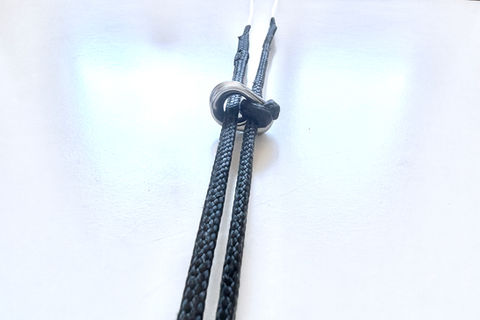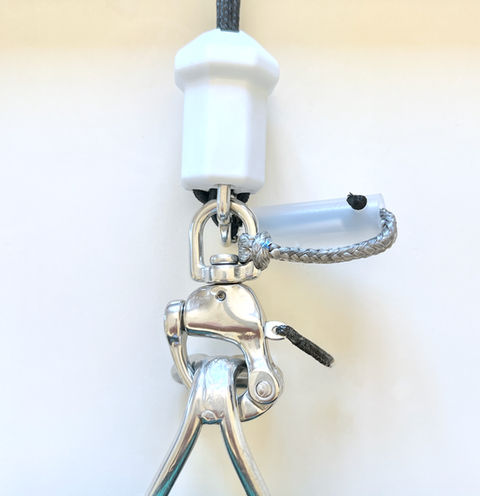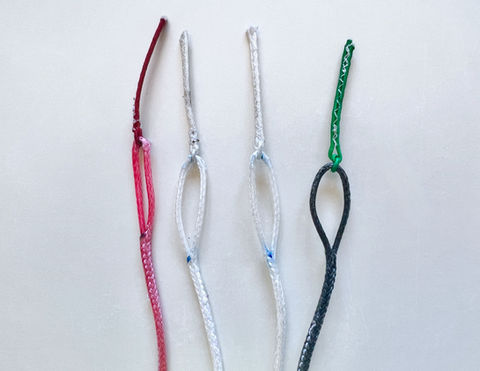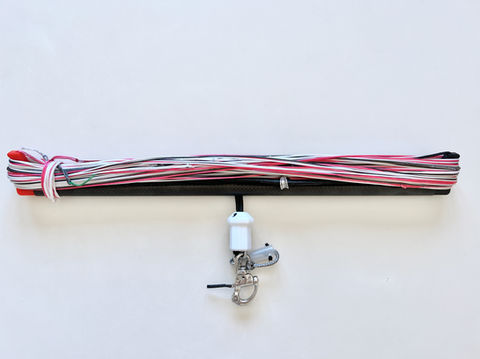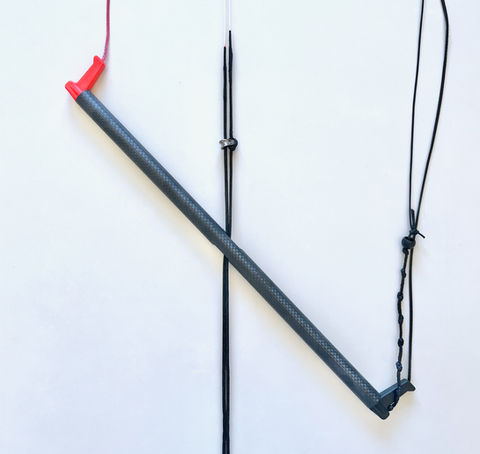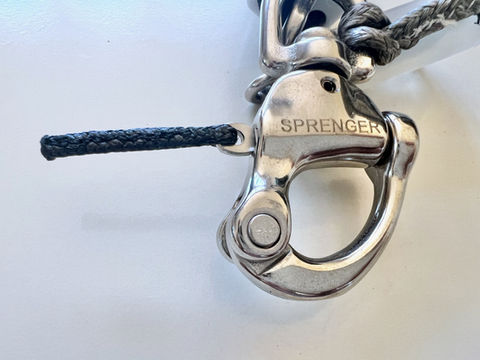

MY BAR FOR WAVE, FOIL & FREERIDE
SIMPLE - LIGHT - SAFE

Simple
Big floaters or chunky bumpers at the bar ends you will not find on my bar. I focused on the essentials because I do not want to concentrate on the bar while riding. Everything that is superfluous I just leave it beside, but always with 100% focus of the full functionality. Less is really more in the end!
Light
Following to the principle of my product philosophy my bar must be pretty light. Most bars on the market weigh complete setup between 900 and 1400 gr including lines and quickrelease. My bar only weighs about 432 grams in 52cm width with the same equipment. If you think that you do not notice this much lower weight when riding this bar anyway I can only advise that you never to try such a light bar, because there is an increased addictive potential!


Safe
While riding nothing should hang around or dangle in which I could get tangled. I want to have the full safety and comfort at all times. Therefore my bar has a single frontline safety which is activated by a central push-away quick release and an adjuster which is integrated into the bar and laterally adjustable. How this works exactly I explain further down on the page. The quickrelease is small, but grippy and clearly visible. I often ride in waves so it's also very important to me that I can seperate me from the entire bar system with only very few action. I explain the advantages of that further down on the page.
FEATURES
"It was a long way to design a completely new bar test it and get it ready for serial production, but that's exactly how my bar should look like."
Bar-Tube made of Carbon
In my view it does not make any sense why a bar is built from raw materials that are heavy on one hand and on the other hand never completely free of problems in salt water. Therefore I have decided to take a bar made of carbon fiber tube. This carbon tube is industrially manufactured in very precise moulds made of metal and has tolerances of less than 1/100 mm. The majority of the carbon fibers are longitudinally oriented for maximum rigidity and breaking load. The outer layer holds the underlying fibers together and gives the whole construction a special solid statics. Due to the much higher fiber content in the laminate such an industrially manufactured carbon bar is much more stable and with only 96 gr much lighter than a hand-laminated bar where usually too much resin is in the laminate. The carbon surface is sanded so always very grippy and never feels cold. It has no EVA-grip which sometimes likes to peel off, or looks ugly after a short time in use.


Integrated Adjuster
At my pintxo bar I prefer to trim the adjuster over both backlines rather than the frontlines as usual. This adjuster I have integrated into the bar which makes my bar system much tidier and I get nowhere tangled, or can hook undesired. There is only very little pull on the backlines compared to the frontlines which makes the handling of the adjuster much easier now. The adjuster is located at the right end of the bar and is always easy to reach even with shorter arms. The adjuster also has an especially large adjustment range of 15cm so that even with very large kites enough way is available. The adjustment takes place in 3cm steps as you can clearly see on the left in the video. Simply pull the adjuster line out of the right end of the bar and let a knot at the desired position lock again at the end of the bar. This is done by simply letting go of the adjuster line.
Anyone who likes kiting in the waves like me and has already been washed by white water will appreciate a tidy bar.
Adjustable Depower-Throw
While foiling and riding the waves as well as during freeriding it is extremely important to have the kite completely without pull. Depending on what you are doing a kite without pull often decides whether to go swimming or to save the situation. On the foil this is even more important, because at the beginning you are regularly too fast and the kite pulls and pulls although the bar is already at the top end of the depower-rope. Most standard bars have a depower throw of only about 45-48 cm which is actually not enough to put the kite completely depowered. A longer way of depower is hardly possible, because otherwise you would not be able to reach the adjuster, because the arms are sometimes simply too short. In addition most chickenloops together with the quickrelease are far too long thus losing valuable depower way. My Pintxo bar on the other hand has an extremely short quickrelease and the adjuster is integrated into the bar. This allows my bar to have a very long depower throw of max. 65cm.. So it's totally easy to set the kite off and it makes you feel much safer and more comfortable, but you always can hold the bar even if it's at the top of the stopper. Anyone who has made a few rides with my Pintxo bar tells me about this new experience of security when he gets back to beach. In gusty areas you do not want to miss that once you have tested it. What's new now is that you can easily move the line splitter down or up and thus freely adjust the depower throw for yourself. This is especially helpful for kiters who do not have long arms.


Safety-System
Today's usual standard on the bar-systems is really good and offers acceptable security. The single-frontline safety (SLS) has ruled almost everywhere and makes the kite nearly powerless when the quickrelease is activated. However I was always bothered that if I want to disconnect myself from the entire system I have to activate first the quickrelease and search then for the safetyleash. Moreover such a long and hanging-around safetyleash could also easily wrap around the bar in my view if you crash hard. Therefore, my safety system is clearly different in two points from the common bar systems, because I have deliberately omitted a chicken loop and given a snapshakle the preference. Beside this my safety system has an extremely short safetyleash which cannot hook in anywhere accidentially.
Lines
I do not want to compromise on the flying lines and only rely on the lines of the company named Liros from German production. I only accept a very direct bar feeling with my kites and that's why I decided logically for SK99 lines made from 100% Dyneema. The Liros DC-PRO 401 in 1.55 mm is thin enough to generate only little air drag, but with an effective breaking load of 490 kg it has more than sufficient reserves for the frontlines. For the backlines I have now chosen the Liros DC-PRO 201 with a diameter of only 1.10 mm to reduce the air resistance even further. The breaking load of 230 kg is absolutely sufficient for the backlines. The loops on my flying lines are all spliced in order not to minimize the very high breaking load due to knots etc. At the ends of all flying lines are spliced loops with small flags to separate the lines easily from the kite.


Line-Lengths
My bar comes in the standard setup with 24m line length. The last 9m are existing of three extensions with 3m length with loop-loop connection. Thus you can ride the Pintxo bar with 15m, 18m, 21m and 24m. Both frontlines are in white color. The right backline is in black color and the left backline in orange color. That makes it easier to attach the lines to the kite and helps relaunching the kite in deep water.
Bar-Width
I always trim my kites so that I can ride all sizes with the same bar. I ride the 15m Nerio with the same 52cm bar as the 5m Maverick kite and that works great. I always use two bars for myself. One with 18m lines for the waves and small kites and another bar with 24m for the lower wind range so I have more way to generate power in the kite. Both bars have the same width of 52cm.


Bar-Angle
The use of the new cover line over the flying lines and the larger Depower-Hole on the bar top and bottom allows the bar to be angled very wide without creating friction. Thus the bar feel is fully preserved even at very large angles.
Slide-Protect
The new Slide-Protect cover line is used in the depower throw area. This high-quality line braid made of Dyneema protects the flying lines which run internally. The Slide-Protect material is extremely durable and glides particularly well through the bar. The line splitter is also new. It is made of stainless steel and freely adjustable over the entire depower throw.


Line-Connector
Our kites always have only knots for the front lines and back lines. As a result the flying lines have only loops. So that you can use the Pintxo-Bar but also for other kites we include from now on the bar always 4 small stainless steel rings which make it possible to simulate a knot at the end of the flying lines. Thus you can also fly the Pintxo bar on kites that have a loop on the pigtails, or front lines.
Snap Shackle
The new snap shackle is a high quality product from Sprenger. It is made of stainless steel and very precise in function. The swivel turns very easily even if it has spent a long time in the sand. The release pin is secured by its shape and can not detach itself from its guide. This gives additional safety. The small line for the release pin is only used when you want to hook the bar to the harness, or detach from the bar after kiting. The whole snap shackle has NO safety function. It only serves as a connection from the bar to the harness.


Bar-Bag
For the light Pintxo Bar of course the matching bag must be very light and simple, too. It is made of the same material as the Maverick kite bag and just as tough yet lightweight. The Pintxo Bar Bag is included in the delivery of the Pintxo Bar.



